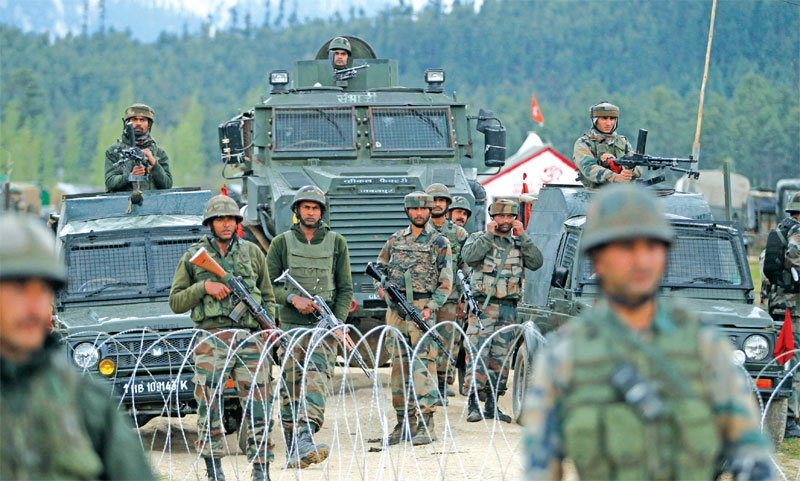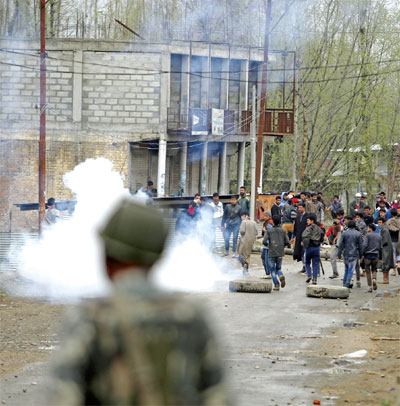Clear cut aim, tactical organisation, winning over locals must drive CI operations
 Brig. Ravi Palsokar (retd)
Brig. Ravi Palsokar (retd)
It is commonly thought that regular troops of the army with their superior numbers, better training and equipment would be more than a match for the best of insurgents. But experience shows it does not quite work like that for the simple reason that the insurgents, operating from a position of want and scarcity of resources, resort to ingenious methods to carry out their activities. Regular soldiers, on the other hand, appear ponderous and slow moving, thus playing into the strengths of the insurgents.
It is only after much experience and trial and error that regular troops become adept at counter-insurgency warfare. But they need rotation. New troops take the place of the old ones, and they make the same mistakes. This cycle continues. It is one thing to recognise the problem and yet another to adapt to it. The Indian Army has ample experience in counter-insurgency warfare and yet we do not seem to progress. Occasionally, there is a glimpse of a resolution, but it is often dashed because of factors over which soldiers have no control, such as a lack of political initiative and reluctance of the civil administration to resume normal activity because of a perceived lack of security. Despite this seemingly gloomy picture, it is possible and indeed desirable to glean some lessons from past experience and see if they can help future practitioners of counter-insurgency warfare.
Counter-Insurgency Aim
The first problem that the troops face in the field is that the tactical aim is not laid down clearly and is often ambiguous. What should be the aim? Simply put, it is to restore normalcy so that the common people can go about their daily lives without let or hindrance. The insurgents want to seize control and run their own administration. This is the cause for battling the insurgents.
It is a fallacy to think that an insurgent movement can be defeated much as a conventional army can be. Insurgency, depending on the stage it is in, has to be degraded to lower levels step by step. From guerrilla warfare to terrorism, or terrorism to a law-and-order situation, so that the civil administration can respond.
These phases are not clear cut nor easy to discern and an insurgency may be at different levels in different districts or sectors. We have so far seen the policy, organisation and intelligence requirements to conduct a successful counter-insurgency warfare. But making these work requires active understanding and participation by the soldiers and their junior leaders for it is on their actions that the success of such operations depend.

Tactical Organisation
The primary task of any formation or unit commander inducted into an insurgency-affected area is to ensure that he has control over the situation as it develops and for that he has to tactically organise his operational area or sector. Given that insurgencies have been going on for many years in the northeast and Jammu and Kashmir, usually an incoming commander or a unit will be handed over operational responsibility from those leaving.
At first it may appear that since whatever is handed over is a time-tested deployment or method of operation, it only needs to be continued with minor changes after taking into account the latest developments. But this does not apply to a formation inducted into a totally new area, an example of which was the Indian Peace Keeping Force when it was deployed in the Tamil areas of Sri Lanka. Whatever be the circumstances or the prevailing situation, any commander worth his salt should examine his area for operational organisation as he sees it. A new commander who introduces changes just because he has taken over is liable to stumble and become unpopular in no time. Change for the sake of change is not necessary. So, what is it that he should do?
Assessing Battlefield
Organising a battlefield means making an assessment of three main factors:
One, the area of operation including the terrain, weather and local conditions;
Two, the level of insurgency including the condition of insurgent groups in the light of the task given to him; and
Three, the division of responsibility between his subordinate units and formations.
The terrain and weather are constant factors but understanding them is essential. Certain areas are easy to access and some difficult because of the prevalence of cover such as woods or forests. There is also the availability of water. All these form part of the understanding of the area of operations. This requires a detailed study.
One example should suffice. Certain parts of the northeast are covered by bamboo jungles. Bamboos flower just once in their lifetime and it is considered an ill omen by the locals because it is accompanied by an increase in the rodent population, which often leads to famine. The Mizoram example of 1958, when the state’s request for assistance was ignored by the central government, led to drought and famine and was the cause for the subsequent insurgency.
To quote, ‘There is something mysterious about bamboo flowering. Members of a species will flower simultaneously. This means forests of bamboo separated by hundreds of kilometres will flower at the same time. Scientists are not sure of how and why this happens.’ Weather dictates the tempo of operations. The key point is that these factors affect the insurgents as well as the security forces equally, but the insurgents have the advantage of being native to local conditions while the troops have to work hard to adapt to the new conditions.
 Countering Insurgents
Countering Insurgents
Counter-insurgency operations must be aimed at the activities of the insurgents. This requires an analysis of the strengths and weaknesses of the local adversaries. Often the entire area of operation is considered homogenous, even if the terrain and other conditions differ from area to area. Sometimes, local difficulties and aspirations tend to be different within the same community and ethnicity. Regular troops or rather their commanders are slow to recognise this.
An example will illustrate this. When we were fighting the LTTE in northern Sri Lanka, my brigade’s area of operation consisted of an overwhelmingly Tamil population. We assumed that the beliefs and aspirations of all the Tamils would be uniform. But it was not so. It was only later we recognised that there were local tensions and divisions. During our deployment of two years, three elections were held. They were opposed by the LTTE, and the polling turnout was abysmally low. But there were three or four villages in one corner of our sector that saw high election turnout. At the first time we did not understand this and frankly we were very busy keeping the LTTE at bay, so we gave little thought to it.
When it happened a second time, inquiries revealed that this particular set of Tamils had been resettled from another area and they were treated with suspicion by the LTTE. This was their way of showing dissent to the LTTE. Sadly, we were slow to react and failed to reach out to them. But looking back I recognise that this was an opportunity we could have exploited. It is by making sense of such incidents that successful counter-insurgency operations are conducted.
Aim of Activity
A major strength of the insurgents is continuous activity. They have to do so to keep their cause alive in the public eye. This is best achieved by taking on and inflicting casualties on the security forces all the time. The advantage is that if it is successful, it puts the security forces on the defensive. Regular troops have larger numbers with better and greater resources, but they have to be optimally utilised.
Returning to the IPKF experience, there was a period in the initial stages when it was decided to counter these insurgent tactics by continuous activity by the troops. Our senior headquarters had ordered that all the posts had to have one third of the troops outside at all times to keep the LTTE under pressure. This initiative collapsed quite quickly for the simple reason that it fatigued the troops because activity was being conducted only for the sake of it. It took a long time thereafter to get the troops back in the right frame of mind.
There were two lessons from this experience. First, an activity must have an aim and hurt the adversary, if not through encounters, then by making their movement difficult. Otherwise, such activities are self-defeating. Second, troops need rest and recreation, otherwise they become bored and careless. How to do this is the test of leadership in the field.
The insurgents tend to be familiar with the local area and find it easy to move about and meld with the population, which makes it difficult for the security forces to recognise active insurgents. It must be recognised that insurgents can ill-afford casualties but at the same time they find it quite easy to fill their ranks, so just counting kills is hardly a winning strategy. Accumulating small continuous successes puts the insurgents on the defensive and forces them to increase the tempo of their activities, which plays into the hands of the troops because the insurgents are forced to come out in the open.
It is useful to divide the area where insurgents are active into black, grey and white categories, where black is the most affected and so on. It then becomes clearer as to where additional effort is required. Similarly, every commander has a span of control, so just adding units and formations under his command is not feasible beyond a certain point.
Optimising Deployment
A commander must be able to react to unforeseen contingencies and this can only be done by maintaining a balanced deployment. The basic principles of mutual support, depth, all-round defence, administration and reserves must be inherent in any deployment and if the terrain conditions force a particular form of deployment, then sufficient contingency plans must be kept ready to react to unforeseen situations.
Counter-insurgency actions can and should be of two types. The first is to force the insurgents to move their base and rethink their strategy. This requires time and continuity. The second is routine activity such as road opening and patrolling to keep the insurgents from settling in. It is not possible for one unit to do both the tasks, but a unit with a limited tenure can do so secure in the knowledge that relief is planned related to their actions.
A formation’s area should have two types of deployment, one of longer tenure where troops are used only for planned specific operations and the other of shorter duration, where troops are pressed into action repeatedly and replaced more frequently before they get fatigued into inaction. In J&K, the Rashtriya Rifles units combine within their organisation sufficient troops to do both the tasks. But they have continuous turnovers selected from all arms and services unlike a regular unit, which operates with a fixed establishment of troops. Combine this with local and central armed police forces and a formidable organisation can be built up.
Winning Locals
One of the major tasks of the troops deployed in counter-insurgency is to gain the confidence of the locals. This can be and is done in a number of ways and hurts the insurgents cause more than any coercive measures. Army doctors attending to the civil population are always welcome. Helping with simple administrative tasks such as setting up water points or sending a water truck to remote locations helps the local women from much back-breaking work. It is surprising how much goodwill can be earned in this manner. Any initiative involving personal commitment of the troops or even their families helps to establish the sincere intentions of the security forces.
A brigade commander in Nagaland showing rare sensitivity had become quite popular. The Brigadier’s two little boys would attend the local school and play with their classmates. One day, the local priest came with an unusual request. The priest invited the Brigadier’s boys to come and spend a weekend with their class friends in a village some distance away. It is one thing for soldiers to take risks, but to expose two kids was unusual, to say the least. The Brigadier and his wife gave it a deep thought and agreed and allowed the boys to go. They returned after two days in local dress, having had a wonderful time and loaded with gifts. They had been treated as guests by the whole village. Needless to say, the situation in that particular area improved beyond recognition. This example can hardly be recommended for emulation but just goes to show what is possible.
In another example, this time in a particularly troublesome area of the Kashmir valley, the wife of the local army commanding officer received an invitation from the women of a nearby village to come and attend a wedding including all festivities over two or three days. The commanding officer’s wife accepted the invitation. She not only attended the wedding, but personally made the bridal make-up and that of the other women of the family. She took part in the singing and dancing and was made very welcome. When she returned, all other nearby villages now vied to invite her. Is this counter-insurgency? Yes, it is and more power to such innovative personal involvement. The point is simple, the insurgents have to be contested on every single front. The battle is not only of body counts but genuine efforts in winning the hearts and minds of the local people.
Counter-insurgency operations are complex at the best of times. Even when all factors are taken into account, it is the leadership at all levels that makes the difference.

